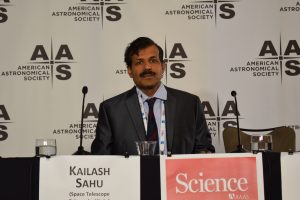
Austin, Texas, Jun 7 (EFE).- An international team of astronomers has used the Hubble space telescope to measure the mass of a star employing Albert Einstein’s Theory of Relativity, something the German physicist longed to do but found to be “impossible” during his lifetime.
Researchers with NASA’s Space Telescope Science Institute in Baltimore, Maryland, measured the mass of a white dwarf star by analyzing how much it bent the light of a more distant star, just as Einstein asserted could be done more than a century ago.
This technique “opens a new window” on determining a star’s mass, a very important fact in estimating how much longer a star has to live, STSCI researcher Kailash Sahu said at a press conference.
The study was presented on Wednesday in Austin, Texas, at the 230th American Astronomical Society conference, where scientists from research centers and universities are discussing their latest discoveries.
Specifically, the team led by Sahu observed a white dwarf star known as Stein 2051B located about 17 light years from Earth just as it passed in front of a more distant star.
During the alignment, the gravity of the white dwarf bent the light from the farther star, thus making the latter appear to shift approximately two thousandths of an arc-second from its original position, a movement so small that it’s equivalent to the size of an ant spotted from more than 2,400 kilometers (about 1,500 miles) away.
This method of “microlensing” is a very independent and direct way of determining the mass of a star, Sahu said.
By measuring the deflection of the more distant star’s light, the astronomers calculated that the white dwarf star has about 68 percent of the Sun’s mass, a result that coincides with theoretical predictions.
The finding allowed the team to get a solid estimate of the white dwarf star’s mass and make predictions about its structure and composition, the Indian researcher said.
The method was proposed in 1915 when Einstein made public his General Theory of Relativity, which – among other things – described how objects deform space according to their mass.
The theory was verified experimentally four years later when a team headed by British astronomer Sir Arthur Eddington measured how the Sun’s gravity shifted the image of a distant star whose light just grazed the solar surface on its way to Earth during a solar eclipse, thus proving that Einstein’s microlensing idea was valid.
Astronomers nowadays use this effect to magnify images of distant galaxies and to measure small changes in the apparent positioning of nearby stars in the sky.
However, researchers had to wait for a century to build a telescope that was powerful enough to detect the gravitational lensing phenomenon caused by a single star outside our solar system.
The amount of deflection is so small that only the ultra-sharply focused Hubble telescope could detect it and the team had to wait for about two years before the two stars came into the proper alignment.
